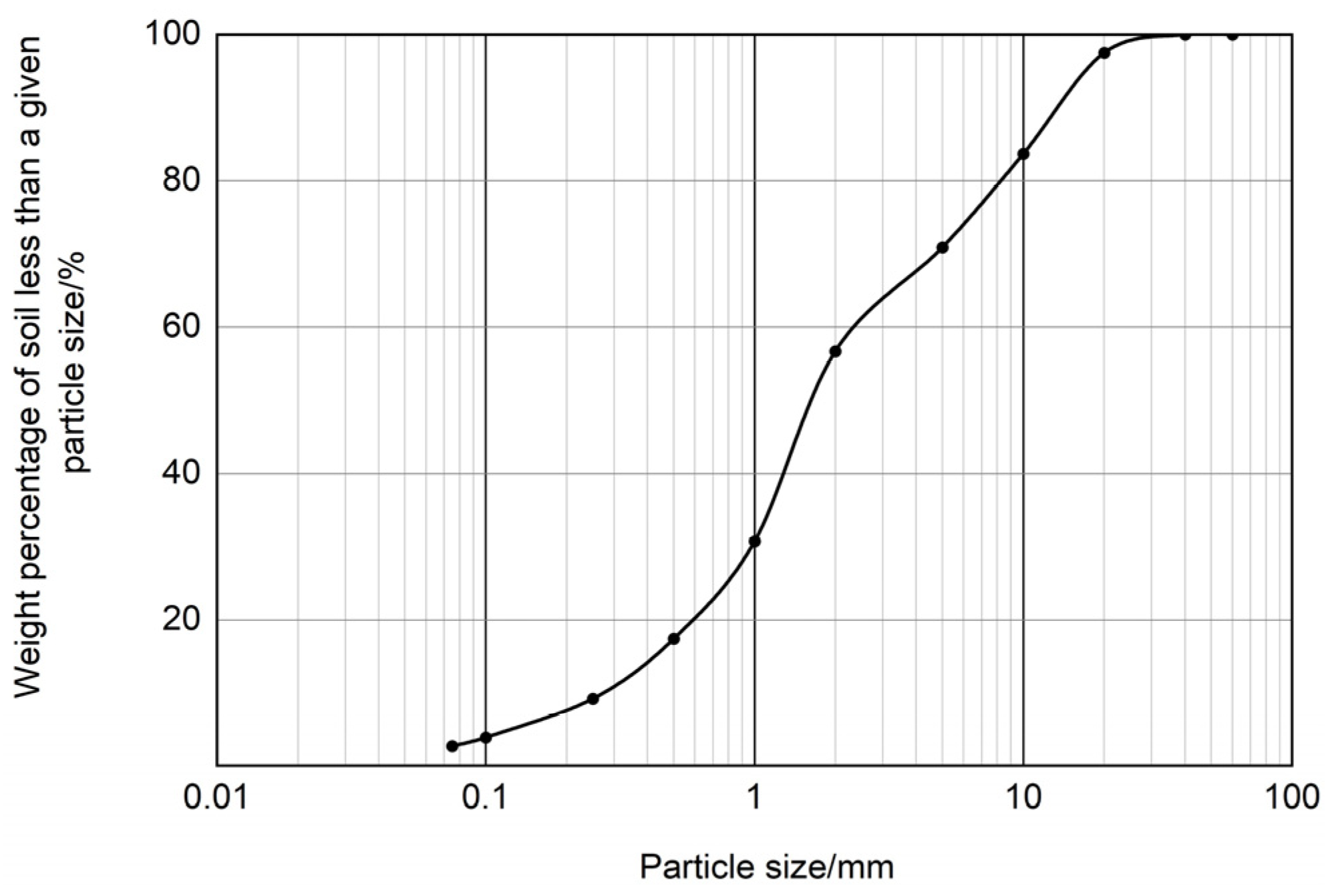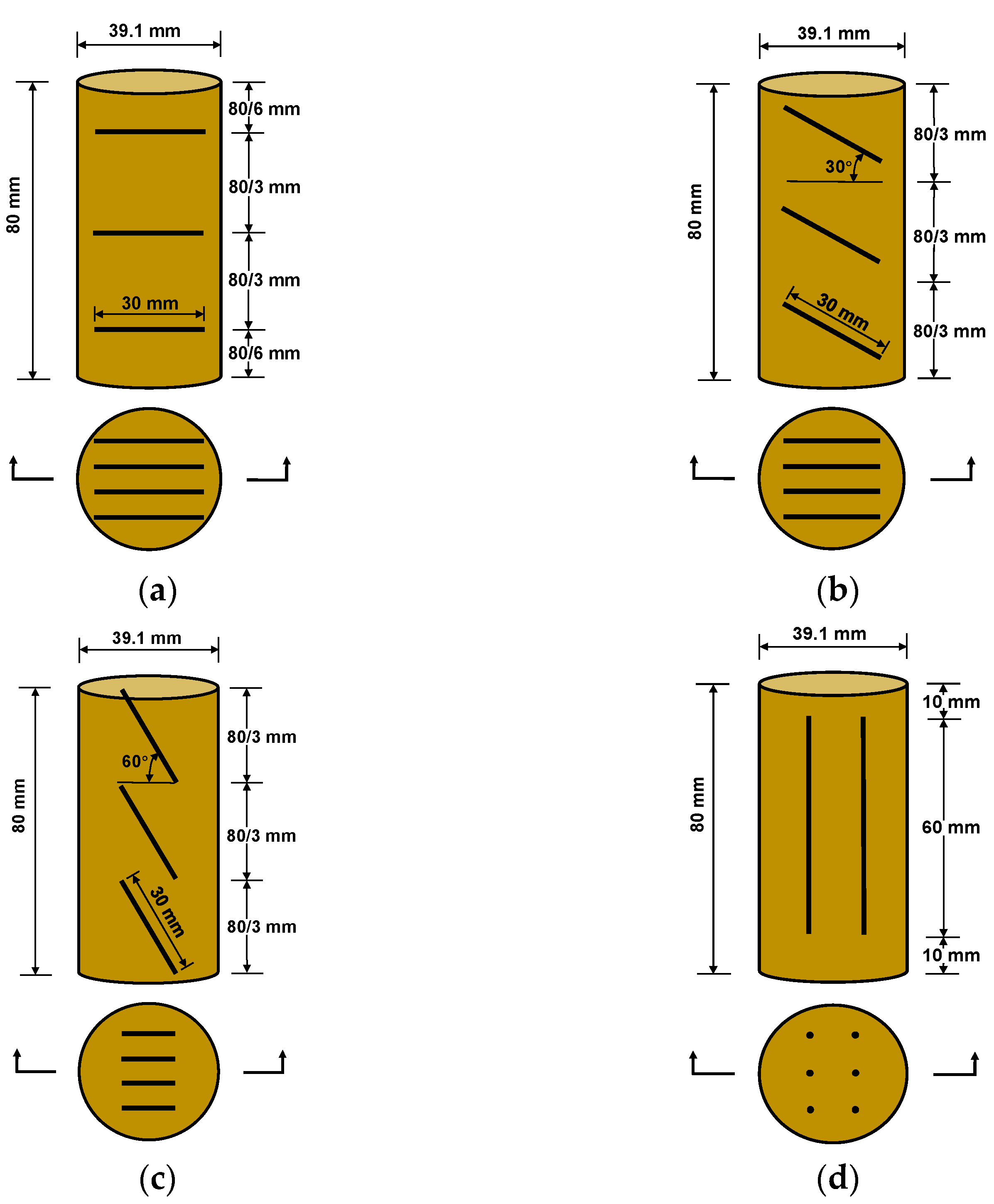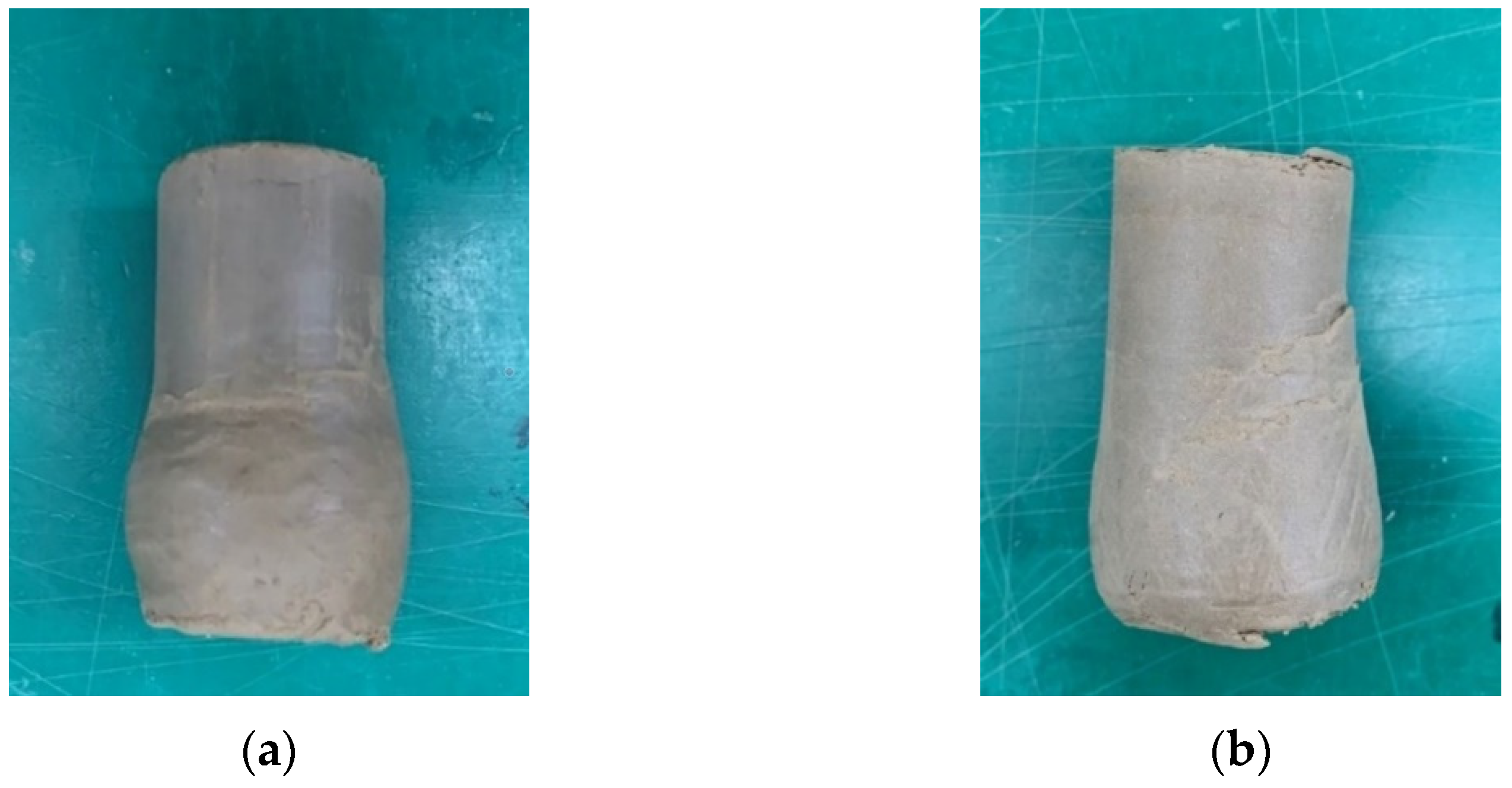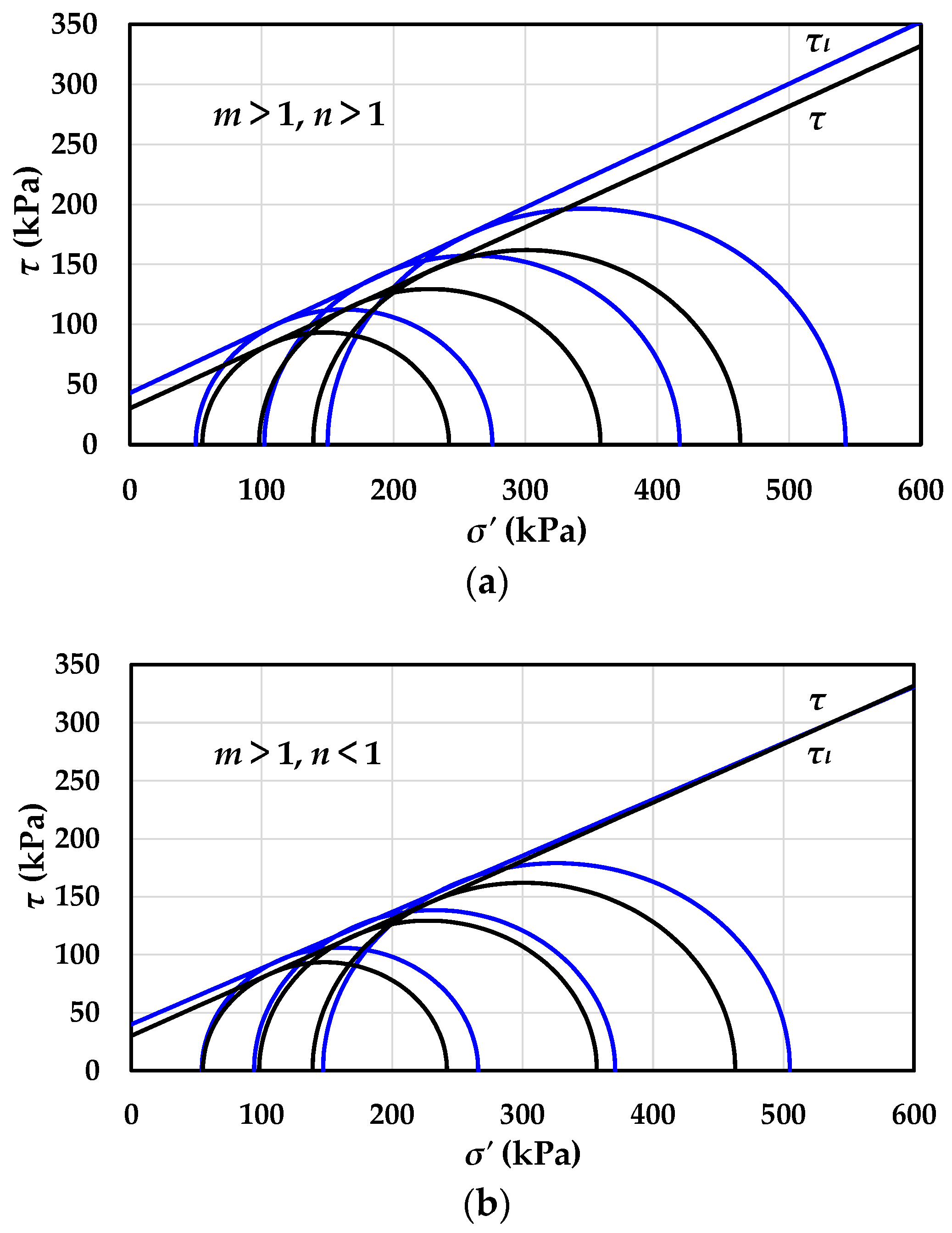Study on the Shear Strength of Root-Soil Composite and Root Reinforcement Mechanism
Abstract
:1. Introduction
2. Materials and Experimental Methods
2.1. Experimental Materials
2.2. Experimental Methods
3. Limit Equilibrium Equation of Root-Soil Composites
4. Results
4.1. Shear Strength Parameters of Root-Soil Composites
4.2. Root Reinforcement Coefficients
4.3. Deformation Characteristics of the Soil Samples
5. Discussion
5.1. Effects of Root Distribution Angles
5.2. Effects of Root Diameter on the Root-Soil Composites
5.3. Variations of the Root Reinforcement Coefficients
5.4. Root Reinforcement Mechanism
6. Conclusions
- Root distribution angles and root diameters affect the shear strengths of the root-soil composites and the shear strength of rooted soils is enhanced by 1.1–2.5 times. The shear strength of the root-soil composites becomes high in the order of 60°, 30°, 0°, and 90° distribution angles, and decreases in the order of 2.0 mm, 1.0 mm, and 0.5 mm root diameters. Moreover, roots mainly affect the effective cohesion of the soils. However, the effective internal friction angle of the rooted soils changes slightly.
- The run-through rate and the lateral deformation of the root-soil composites increase in the order of 90°, 0°, 30°, and 60° root distribution angles (α), and the run-through rate of α = 90° and α = 0° are both 0. Meanwhile, the lateral deformation rate declines from 17.0% for α = 60° to 10.9% for α = 90°. Roots can effectively restrain the deformation of the root-soil composites.
- Two root reinforcement coefficients n and m were proposed to develop the limit equilibrium equation of the root-soil composites. n and m can be calculated by φ′ and c′. The limit equilibrium of the unreinforced soil is equivalent to that of the root-soil composite when both n and m are 1.000, which means that the limit equilibrium equation of the unreinforced soil is only a particular case. Therefore, the limit equilibrium equation of the root-soil composites has a wide applicability. Additionally, n and m represent the effects of root distribution angles and root diameters on the failure principal stress of the root-soil composites, respectively. The failure principal stress of the root-soil composites is positively correlated with n and m.
Author Contributions
Funding
Institutional Review Board Statement
Informed Consent Statement
Data Availability Statement
Conflicts of Interest
Notation
| Shear strength | |
| Normal stress | |
| Pore water pressure | |
| Effective stress | |
| Effective cohesion | |
| Effective internal friction angle | |
| Confining pressure | |
| Failure principal stress of the unreinforced soil | |
| Failure principal stress of the root-soil composite | |
| Passive earth pressure coefficient of the unreinforced soil | |
| Passive earth pressure coefficient of the root-soil composite | |
| Effective cohesion of the unreinforced soil | |
| Effective internal frictional angle of the unreinforced soil | |
| Effective cohesion of the root-soil composite | |
| Effective internal frictional angle of the root-soil composite | |
| Deviator of the failure principal stress of the unreinforced soil and root-soil composite | |
| Generalized equivalent confining pressure | |
| , | Root reinforcement coefficients of the soil |
References
- Kim, D.H.; Gratchev, I.; Balasubramaniam, A. Determination of joint roughness coefficient (JRC) for slope stability analysis: A case study from the Gold Coast area, Australia. Landslides 2013, 10, 657–664. [Google Scholar] [CrossRef] [Green Version]
- Wu, L.Z.; Selvadurai, A.P.S.; Zhang, L.M.; Huang, R.Q.; Huang, J.S. Poro-mechanical coupling influences on potential for rainfall-induced shallow landslides in unsaturated soils. Adv. Water Resour. 2016, 98, 114–121. [Google Scholar] [CrossRef]
- Lin, F.; Wu, L.Z.; Huang, R.Q.; Zhang, H. Formation and characteristics of the Xiaoba landslide in Fuquan, Guizhou, China. Landslides 2018, 15, 669–681. [Google Scholar] [CrossRef]
- Wu, L.Z.; Li, S.H.; Huang, R.Q.; Xu, Q. A new grey prediction model and its application to predicting landslide displacement. Appl. Soft. Comput. 2020, 95, 106543. [Google Scholar] [CrossRef]
- Li, S.H.; Luo, X.H.; Wu, L.Z. A new method for calculating failure probability of landslide based on ANN and convex set model. Landslides 2021, 18, 2855–2867. [Google Scholar] [CrossRef]
- Zhu, S.R.; Wu, L.Z.; Huang, J.S. Application of an improved P(m)-SOR iteration method for flow in partially saturated soils. Comput. Geosci. 2022, 26, 131–145. [Google Scholar] [CrossRef]
- Zhu, S.R.; Wu, L.Z.; Song, X.L. An improved matrix split-iteration method for analyzing underground water flow. Eng. Comput. 2022, Online. [Google Scholar] [CrossRef]
- Montagnoli, A.; Terzaghi, M.; Magatti, G.; Scippa, G.S.; Chiatante, D. Conversion from coppice to high stand increase soil erosion in steep forestland of European beech. Reforesta 2016, 2, 60–75. [Google Scholar] [CrossRef] [Green Version]
- Zegeye, A.D.; Langendoen, E.J.; Tilahun, S.A.; Mekuria, W.; Poesen, J.; Steenhuis, T.S. Root reinforcement to soils provided by common Ethiopian highland plants for gully erosion control. Ecohydrology 2018, 11, 1940–1951. [Google Scholar] [CrossRef]
- Mitsch, W.J. Ecological engineering—The 7-year itch. Ecol. Eng. 1998, 10, 119–138. [Google Scholar] [CrossRef]
- Osman, N.; Barakbah, S.S. Parameters to predict slope stability—Soil water and root profiles. Ecol. Eng. 2006, 28, 90–95. [Google Scholar] [CrossRef]
- Wu, T.H. Root reinforcement of soil: Review of analytical models, test results, and applications to design. Can. Geotech. J. 2013, 50, 259–274. [Google Scholar] [CrossRef]
- Ai, X.Y.; Wang, L.; Xu, D.P.; Rong, J.J.; Ai, S.H.; Liu, S.; Li, C.L.; Ai, Y.W. Stability of artificial soil aggregates for cut slope restoration: A case study from the subalpine zone of southwest China. Soil Till. Res. 2021, 209, 104934. [Google Scholar] [CrossRef]
- Li, S.H.; Cui, P.; Cheng, P.; Wu, L.Z. Modified Green–Ampt Model considering vegetation root effect and redistribution characteristics for slope stability analysis. Water Resour. Manag. 2022, 36, 2395–2410. [Google Scholar] [CrossRef]
- McGuire, L.A.; Rengers, F.K.; Kean, J.W.; Coe, J.A.; Mirus, B.B.; Baum, R.L.; Godt, J.W. Elucidating the role of vegetation in the initiation of rainfall-induced shallow landslides: Insights from an extreme rainfall event in the Colorado Front Range. Geophys. Res. Lett. 2016, 43, 9084–9092. [Google Scholar] [CrossRef] [Green Version]
- Gonzalez-Ollauri, A.; Mickovski, S.B. Plant-soil reinforcement response under different soil hydrological regimes. Geoderma 2017, 285, 141–150. [Google Scholar] [CrossRef] [Green Version]
- Feng, S.; Liu, H.W.; Ng, C.W.W. Analytical analysis of the mechanical and hydrological effects of vegetation on shallow slope stability. Comput. Geotech. 2020, 118, 103335. [Google Scholar] [CrossRef]
- Löbmann, M.T.; Geitner, C.; Wellstein, C.; Zerbe, S. The influence of herbaceous vegetation on slope stability-A review. Earth-Sci. Rev. 2020, 209, 103328. [Google Scholar] [CrossRef]
- Zhu, H.; Zhang, L.M.; Garg, A. Investigating plant transpiration-induced soil suction affected by root morphology and root depth. Comput. Geotech. 2018, 103, 26–31. [Google Scholar] [CrossRef]
- Yildiz, A.; Graf, F.; Rickli, C.; Springman, S.M. Assessment of plant-induced suction and its effects on the shear strength of rooted soils. Geotech. Eng. 2019, 172, 507–519. [Google Scholar] [CrossRef] [Green Version]
- Liu, H.W.; Feng, S.; Ng, C.W.W. Analytical analysis of hydraulic effect of vegetation on shallow slope stability with different root architectures. Comput. Geotech. 2016, 80, 115–120. [Google Scholar] [CrossRef]
- Ng, C.W.W.; Zhang, Q.; Ni, J.J.; Li, Z.Y. A new three-dimensional theoretical model for analysing the stability of vegetated slopes with different root architectures and planting patterns. Comput. Geotech. 2021, 130, 103912. [Google Scholar] [CrossRef]
- Su, X.M.; Zhou, Z.C.; Liu, J.E.; Cao, L.G.; Liu, J.Y.; Wang, P.P. Estimating slope stability by the root reinforcement mechanism of Artemisia sacrorum on the Loess Plateau of China. Ecol. Model 2021, 444, 109473. [Google Scholar] [CrossRef]
- Jiang, K.Y.; Chen, L.H.; Gai, X.G.; Yang, W.J. Relationship between tensile properties and microstructures of three different broadleaf tree roots in North China. Trans. Chin. Soc. Agric. Eng. 2013, 29, 115–123. (In Chinese) [Google Scholar]
- Zhang, C.B.; Chen, L.H.; Liu, Y.P.; Ji, X.D.; Liu, X.P. Triaxial compression test of soil-root composites to evaluate influence of roots on soil shear strength. Ecol. Eng. 2010, 36, 19–26. [Google Scholar] [CrossRef]
- Wu, T.H. Investigation of Landslides on Prince of Wales Island, Alaska; Geotechnical Engineering Report 5; Department of Civil Engineering, Ohio State University: Columbus, OH, USA, 1976. [Google Scholar]
- Waldron, L.J. The shear resistance of root-permeated homogeneous and stratified soil. Soil Sci. Soc. Am. J. 1977, 41, 843–849. [Google Scholar] [CrossRef]
- Wu, T.H.; McKinell, W.P.; Swanston, D.N. Strength of tree roots and landslides on Prince of Wales Island, Alaska. Can. Geotech. J. 1979, 16, 19–33. [Google Scholar] [CrossRef]
- Gray, D.H.; Sotir, R.B. Biotechnical and soil bioengineering slope stabilization: A practical guide for erosion control. Soil Sci. 1998, 163, 83–85. [Google Scholar] [CrossRef]
- Pollen, N.; Simon, A. Estimating the mechanical effects of riparian vegetation on stream bank stability using a fiber bundle model. Water Resour. Res. 2005, 41, 226–244. [Google Scholar] [CrossRef]
- Schwarz, M.; Preti, F.; Giadrossich, F.; Lehmann, P.; Or, D. Quantifying the role of vegetation in slope stability: A case study in Tuscany (Italy). Ecol. Eng. 2010, 36, 285–291. [Google Scholar] [CrossRef]
- Satyanaga, A.; Rahardjo, H. Stability of unsaturated soil slopes covered with Melastoma malabathricum in Singapore. Proc. Inst. Civ. Eng.-Geotech. Eng. 2019, 172, 530–540. [Google Scholar] [CrossRef]
- Rahardjo, H.; Satyanaga, A.; Wang, C.L.; Wong, J.L.H.; Lim, V.H. Effects of unsaturated properties on stability of slope covered with Caesalpinia Crista in Singapore. Environ. Geotech. 2020, 7, 393–403. [Google Scholar] [CrossRef]
- Zhou, Y.Y.; Wang, X.M. Mesomechanics characteristics of soil reinforcement by plant roots. Bull. Eng. Geol. Environ. 2019, 78, 3719–3728. [Google Scholar] [CrossRef]
- Zhang, C.B.; Chen, L.H.; Jiang, J. Vertical root distribution and root cohesion of typical tree species on the Loess Plateau, China. J. Arid. Land 2014, 6, 601–611. [Google Scholar] [CrossRef]
- Lian, B.Q.; Peng, J.B.; Zhan, H.B.; Wang, X.G. Mechanical response of root-reinforced loess with various water contents. Soil Till. Res. 2019, 193, 85–94. [Google Scholar] [CrossRef]
- Guo, P.; Xia, Z.; Liu, Q.; Xiao, H.; Gao, F.; Zhang, L.; Li, M.Y.; Yang, Y.S.; Xu, W.N. The mechanism of the plant roots’ soil-reinforcement based on generalized equivalent confining pressure. PeerJ 2020, 8, e10064. [Google Scholar] [CrossRef]
- Liu, Y.B.; Hu, X.S.; Yu, D.M.; Zhu, H.L.; Li, G.R. Influence of the roots of mixed-planting species on the shear strength of saline loess soil. J. Mt. Sci. 2021, 18, 806–818. [Google Scholar] [CrossRef]
- ASTM (D4287-11); Standard Practice for Classification of Soils for Engineering Purpose (Unified Soil Classification System). ASTM International: West Conshohocken, PA, USA, 2006.
- ASTM. (D854-02); Standard Test Methods for Specific Gravity of Soil Solids by Water Pycnometer. Annual Book of ASTM Standards. ASTM International: West Conshohocken, PA, USA, 2002.
- ASTM. (D4318-00); Standard Test Methods for Liquid Limit, Plastic Limit and Plasticity Index of Soils. Annual Book of ASTM Standards. ASTM International: West Conshohocken, PA, USA, 2000.
- Li, Y.P.; Wang, Y.Q.; Ma, C.; Zhang, H.L.; Wang, Y.J.; Song, S.S.; Zhu, J.Q. Influence of the spatial layout of plant roots on slope stability. Ecol. Eng. 2016, 91, 477–486. [Google Scholar] [CrossRef]
- Gyssels, G.; Poesen, J.; Bochet, E.; Li, Y. Impact of plant roots on the resistance of soils to erosion by water: A review. Prog. Phys. Geogr. 2005, 29, 189–217. [Google Scholar] [CrossRef] [Green Version]
- Alam, S.; Banjara, A.; Wang, J.; Patterson, W.B.; Baral, S. Novel approach in sampling and tensile strength evaluation of roots to enhance soil for preventing erosion. Open J. Soil Sci. 2018, 8, 330–349. [Google Scholar] [CrossRef] [Green Version]
- Cazzuffi, D.; Crippa, E. Shear strength behaviour of cohesive soils reinforced with vegetation. In Proceedings of the 16th International Conference on Soil Mechanics and Geotechnical Engineering: Geotechnology in Harmony with the Global Environment, Osaka, Japan, 12 September 2005. [Google Scholar]
- Fan, C.C.; Su, F. Role of roots in the shear strength of root-reinforced soils with high moisture content. Ecol. Eng. 2008, 33, 157–166. [Google Scholar] [CrossRef]
- Meng, S.Y.; Zhao, G.Q.; Yang, Y.Y. Impact of plant root morphology on rooted-soil shear resistance using triaxial testing. Adv. Civ. Eng. 2020, 2020, 8825828. [Google Scholar] [CrossRef]
- Tan, H.M.; Chen, F.M.; Chen, J.; Gao, Y.F. Direct shear tests of shear strength of soils reinforced by geomats and plant roots. Geotext Geomembr. 2019, 47, 780–791. [Google Scholar] [CrossRef]
- Schmidt, K.M.; Roering, J.J.; Stock, J.D.; Dietrich, W.E.; Montgomery, D.R.; Schaub, T. The variability of root cohesion as an influence on shallow landslide susceptibility in the Oregon Coast Range. Can. Geotech. J. 2001, 38, 995–1024. [Google Scholar] [CrossRef]
- Ji, X.D.; Cong, X.; Dai, X.Q.; Zhang, A.; Chen, L.H. Studying the mechanical properties of the soil-root interface using the pullout test method. J. Mt. Sci. 2018, 15, 882–893. [Google Scholar] [CrossRef]
- Vergani, C.; Chiaradia, E.A.; Bischetti, G.B. Variability in the tensile resistance of roots in Alpine forest tree species. Ecol. Eng. 2012, 46, 43–56. [Google Scholar] [CrossRef]
- Su, L.J.; Hu, B.L.; Xie, Q.J.; Yu, F.W.; Zhang, C.L. Experimental and theoretical study of mechanical properties of root-soil interface for slope protection. J. Mt. Sci. 2020, 17, 2784–2795. [Google Scholar] [CrossRef]
- Rasti, A.; Adarmanabadi, H.R.; Pineda, M.; Reinikainen, J. Evaluating the effect of soil particle characterization on internal friction angle. Am. J. Eng. Appl. Sci. 2021, 14, 129–138. [Google Scholar] [CrossRef]
- Normaniza, O.; Faisal, H.A.; Barakbah, S.S. Engineering properties of Leucaena leucocephala for prevention of slope failure. Ecol. Eng. 2008, 32, 215–221. [Google Scholar] [CrossRef]
- Hu, X.S.; Brierley, G.; Zhu, H.L.; Li, G.R.; Fu, J.T.; Mao, X.Q.; Yu, Q.Q.; Qiao, N. An exploratory analysis of vegetation strategies to reduce shallow landslide activity on loess hillslopes, Northeast Qinghai-Tibet Plateau, China. J. Mt. Sci. 2013, 10, 668–686. [Google Scholar] [CrossRef] [Green Version]







| Particle Size/mm | >10 | 10–5 | 5–2 | 2–1 | 1–0.5 | 0.5–0.25 | 0.25–0.075 | ≤0.075 |
|---|---|---|---|---|---|---|---|---|
| Percentage/% | 16.3 | 12.8 | 14.2 | 25.97 | 13.3 | 8.23 | 6.5 | 2.7 |
| Soil Dry Density (kg/m3) | Water Content (%) | Plastic Limit (%) | Liquid Limit (%) | Plasticity Index | Specific Gravity | Unified Soil Classification System, USCS |
|---|---|---|---|---|---|---|
| 1800 | 16.5 | 15.2 | 30.7 | 15.5 | 2.73 | Well-graded sand with clay and gravel (SW-SC) |
| Strength Parameter | Control Conditions | ||||||||||||
|---|---|---|---|---|---|---|---|---|---|---|---|---|---|
| WR * | 0.5 mm Root Diameter | 1.0 mm Root Diameter | 2.0 mm Root Diameter | ||||||||||
| 0° | 30° | 60° | 90° | 0° | 30° | 60° | 90° | 0° | 30° | 60° | 90° | ||
| c′ (kPa) | 30.17 | 40.00 | 36.88 | 33.70 | 50.21 | 45.43 | 42.14 | 38.99 | 60.27 | 51.92 | 48.64 | 43.03 | 74.15 |
| Δc′ (kPa) | - | 9.83 | 6.71 | 3.53 | 20.04 | 15.26 | 11.97 | 8.82 | 30.10 | 21.75 | 18.47 | 12.86 | 43.98 |
| φ′ (°) | 26.69 | 26.07 | 26.12 | 26.66 | 26.22 | 26.96 | 26.69 | 26.93 | 26.77 | 26.87 | 27.07 | 27.26 | 26.85 |
| Root Reinforcement Coefficient | Control Condition | ||||||||||||
|---|---|---|---|---|---|---|---|---|---|---|---|---|---|
| WR * | 0.5 mm Root Diameter | 1.0 mm Root Diameter | 2.0 mm Root Diameter | ||||||||||
| 0° | 30° | 60° | 90° | 0° | 30° | 60° | 90° | 0° | 30° | 60° | 90° | ||
| n | 1.000 | 0.976 | 0.978 | 0.999 | 0.982 | 1.011 | 1.000 | 1.010 | 1.003 | 1.007 | 1.015 | 1.022 | 1.006 |
| m | 1.000 | 1.326 | 1.222 | 1.117 | 1.664 | 1.506 | 1.397 | 1.292 | 1.998 | 1.721 | 1.612 | 1.426 | 2.458 |
Publisher’s Note: MDPI stays neutral with regard to jurisdictional claims in published maps and institutional affiliations. |
© 2022 by the authors. Licensee MDPI, Basel, Switzerland. This article is an open access article distributed under the terms and conditions of the Creative Commons Attribution (CC BY) license (https://creativecommons.org/licenses/by/4.0/).
Share and Cite
Li, P.; Xiao, X.; Wu, L.; Li, X.; Zhang, H.; Zhou, J. Study on the Shear Strength of Root-Soil Composite and Root Reinforcement Mechanism. Forests 2022, 13, 898. https://doi.org/10.3390/f13060898
Li P, Xiao X, Wu L, Li X, Zhang H, Zhou J. Study on the Shear Strength of Root-Soil Composite and Root Reinforcement Mechanism. Forests. 2022; 13(6):898. https://doi.org/10.3390/f13060898
Chicago/Turabian StyleLi, Pengcheng, Xuepei Xiao, Lizhou Wu, Xu Li, Hong Zhang, and Jianting Zhou. 2022. "Study on the Shear Strength of Root-Soil Composite and Root Reinforcement Mechanism" Forests 13, no. 6: 898. https://doi.org/10.3390/f13060898






